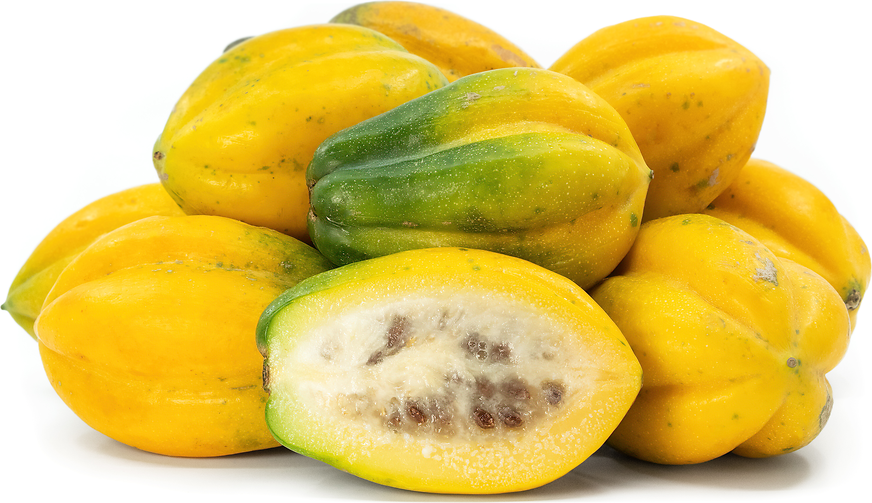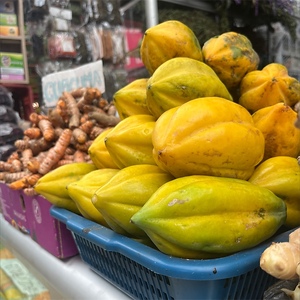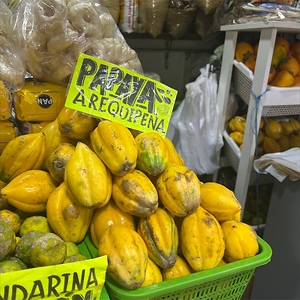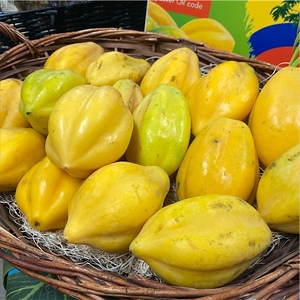


Mountain Papayas
Estimated Inventory, lb : 0
Description/Taste
Mountain papayas are small in size, averaging 6 to 20 centimeters in length and 3 to 8 centimeters in diameter, and have an oblong, cylindrical, oval shape. The fruits typically weigh around 200 grams when ripe and have a distinct appearance with five prominent longitudinal ridges, also known as lobes or ribs. Mountain papayas ripen from green to shades of bright yellow-orange, and the skin is semi-thin, glossy, firm, smooth, and taut. It is important to note that the skin will stay slightly firmer than common papaya varieties when ripe. Underneath the surface, a layer of flesh encases a central chamber filled with gelatinous pulp and round to oval dark brown seeds. The yellow-orange flesh is soft, crisp, succulent, and aqueous, while the ivory-to-milky gelatinous center is slippery and viscous. Mountain papayas are known for their robust, fruity aroma. The entire fruit is edible raw, including the skin, flesh, seeds, and pulp, but most consumers only eat the flesh. Mountain papayas have a naturally sour, acidic, and tangy taste with tropical, fruity nuances reminiscent of strawberries, melons, guavas, and pineapple. The fruits are typically cooked with sweeteners to create a balanced flavor.
Seasons/Availability
Mountain papayas are available year-round in tropical climates, with a peak season in the winter through spring in subtropical regions.
Current Facts
Mountain papayas, botanically classified as Vasconcellea pubescens, are a rare species belonging to the Caricaceae family. The small fruits are sometimes classified as Carica pubescens and grow on evergreen trees reaching 5 to 10 meters in height. Mountain papayas were given their name from their origination site in the Andes Mountains in South America, and the species is known for its productive nature, cold tolerance, and overall hardiness in cultivation. A single Mountain papaya tree can produce 50 to 60 fruits per year, and the trees are often covered in fruits, giving them a full, top-heavy appearance. Mountain papayas thrive in regions with cooler temperatures where common commercial papayas cannot survive, allowing the species to be used as a rootstock to make other papaya cultivars more robust. The fruits are also known by several regional names, including Chilean papaya, Camburo, Papayuela, Mountain Pawpaw, Cundinamarca papaya, papaya de la montana, and papaya de los Andes. Mountain papayas are lesser known than other types of papayas, but the fruits are commercially produced on a small scale, especially in South America. Mountain papayas are valued for their tart, tangy, and distinct taste and are commonly combined with sweeteners in various fresh and cooked preparations.
Nutritional Value
Mountain papayas have not been extensively studied for their nutritional properties. The species is said to contain some vitamin C to strengthen the immune system, fiber to regulate the digestive tract, and iron to develop the protein hemoglobin for oxygen transport through the bloodstream. Mountain papayas may also provide some vitamin A to maintain healthy organ functioning, potassium to balance fluid levels within the body, other antioxidants to protect the cells against the damage caused by free radicals, and B vitamins to assist in producing cells and converting food into energy. The fruits are high in papain, a natural enzyme thought to reduce inflammation, improve digestion, and treat infections. In South America, especially in Colombia, Mountain papayas are traditionally used in infusions of fruit juices and herbs such as lemongrass, peppermint, or lemon balm to lessen symptoms associated with colds and flu.
Applications
Mountain papayas have a fruity, floral, tropical, tart, and tangy taste suited for fresh and cooked preparations. The fruits can be eaten raw, but most consumers choose to sweeten the flesh’s sour taste with sugar. The skin, flesh, and seeds are edible, with the flesh being the most consumed portion, and it is mainly based on preference if the seeds and skin are discarded or eaten. Fresh Mountain papayas are typically blended into various beverages, including juices and smoothies. The fruits are often combined with other tropical fruits to create refreshing beverages and are sold in local markets as a thirst-quenching drink. Mountain papaya juice can also be served warm, or the flesh can be chopped and tossed into salads, fruit medleys, and salsa. In addition to fresh preparations, Mountain papaya is popularly cooked in sugar syrup and simmered into jams, jellies, and preserves. The sweetened mixture can also be added to ice cream, used as a filling in various baked goods, or incorporated into desserts. In South America, dulce de papayuela is a customary dish of cooked Mountain papaya in sugar. Slices of the fruit are candied and served as a stand-alone treat or topped with queso blanco cheese for a sweet and savory taste. Candied Mountain papaya can also be used as a topping over ice cream, especially in vanilla and coconut flavors. Beyond sweet preparations, green Mountain papaya is cooked like a vegetable and is occasionally simmered in soups and stews. The high papain content in the fruit is also utilized as a natural meat tenderizer. Mountain papayas pair well with fruits such as passion fruit, apples, coconuts, strawberries, peaches, and limes, herbs including cilantro, parsley, and mint, sugar, salt, vanilla, and aromatics such as chile peppers, shallots, and ginger. Whole, unopened Mountain papayas will keep at room temperature for a few days to ripen. Once mature, the fruits should be immediately eaten for the best quality and flavor. Sugar-cooked Mountain papayas will keep up to five days in the refrigerator when stored in a sealed container.
Ethnic/Cultural Info
Mountain papayas are a part of a curious myth passed down in the city of La Serena in Chile. Legend has it that in 1548, Captain Juan Cisternas was taken captive by an indigenous people group near the region of Cerro Brillador. Despite his capture, Captain Juan Cisternas was welcomed by the Chief and allowed to live freely among the indigenous people. One day, Captain Juan Cisternas met the Chief’s daughter, Chalalupanqui, and eventually fell in love with her. The Captain asked for the daughter's hand in marriage, and the Chief gave his blessing. Word among the people spread, and it is said another member of the tribe became jealous as he was also in love with Chalalupanqui. The mysterious tribe member ambushed Captain Juan Cisternas and Chalalupanqui and killed the Captain with a battle axe. Chalalupanqui was devastated and rushed to the Captain, crying over his lifeless body. The woman’s tears hit the earth before she, too, was murdered, and the soil that was watered with her tears sprouted a tree that produced tear-shaped fruit. This fruit became known as Mountain papaya, and the tree is known for producing large amounts of fruit in honor of the many tears shed that fateful day. Mountain papayas are still a symbol of La Serena in the present day, and this story is told annually during various town celebrations.
Geography/History
Mountain papayas are native to South America and have a center of origin spanning from Colombia to Central Chile, primarily in the highlands of the Andes Mountains. The species is believed to have been growing wild since ancient times and was spread in the early ages through migrating people groups. Over time, Mountain papayas were selected for cultivation, and the fruits are now gathered through wild and commercially produced trees. Today, Mountain papayas are still found wild in tropical to subtropical forests between 1,500 and 3,000 meters in elevation. The species thrives in humid regions but is also hardy enough to withstand cooler temperatures. Mountain papayas have expanded beyond their native region and are planted as a commercial fruit and rootstock in India, Sri Lanka, Southeast Asia, East Africa, New Zealand, Australia, and the Americas. In New Zealand, Mountain papayas are the only papaya species to have been named a moderately invasive species and are sometimes viewed as a troublesome weed on the north island. When in season, Mountain papayas are sold through local fresh markets, specialty grocers, and distributors worldwide, especially in South American and Asian markets.
Recipe Ideas
Recipes that include Mountain Papayas. One
| The Kitchn |
|
Chilled Papaya Soup with Pisco and Lime |
| Pilar's Chilean Food & Garden |
|
Chilean Papaya Upside-Down Cake |










